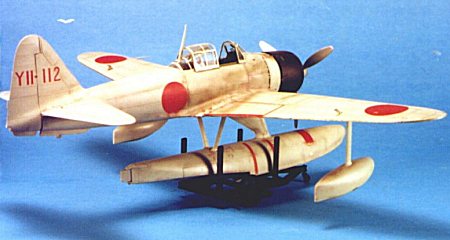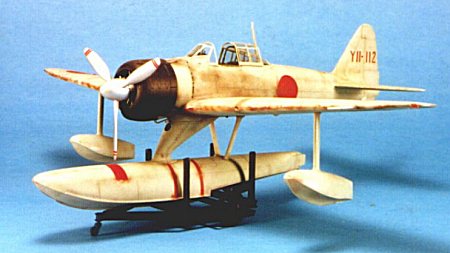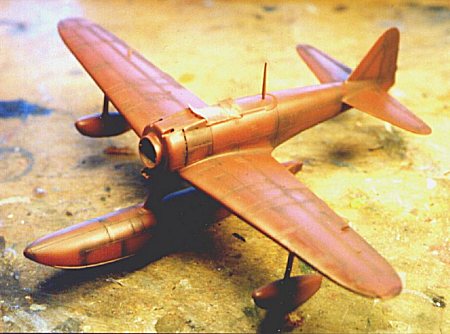
Hasegawa 1/48 A6M2-N 'Rufe'
|
KIT # |
09069 |
|
PRICE: |
$24.98 |
|
DECALS: |
See Review |
|
REVIEW : |
|
|
NOTES: |
|

|
HISTORY |
The floatplane fighter, which appeared in the First World War and was used by both sides with great success, would find its sole use in the Second World War by the Imperial Japanese Navy. While other experimental jet-powered seaborne fighters were developed by Britain, the United States and the Soviet Union after the Second World War, the concept basically died over the Japanese home islands in the spring of 1945.
Masatake Okumiya, former IJN staff officer and historian of the Japanese Navy in the Pacific War, stated in his book, "Zero," that the single thing he found most amazing during the war was the ability of the Americans to carve out airfields as fast as they did after capturing an island. He contrasted this with the inability of the Japanese to ever completely finish the field at Buin, in the Solomons, despite having nearly six months to accomplish this. This is undoubtedly due to the fact that the Japanese had no history of massive, fast-paced construction projects using the latest technology, which had been the American way of going about things for close to a century prior to the Pacific War, and consequently did not have heavy construction equipment in the numbers necessary to accomplish the early construction of such vital installations. It was this difference that led to the only successful floatplane fighter used by any combatant in the Second World War.
 The IJN knew it had a world-beater in the Mitsubishi A6M "Zero"
by September 1940, when one squadron of Zeros completely routed what remained of
Chinese airpower over the mainland. Planning was already afoot for what would
become The Pacific War; one problem planners faced was how to provide air cover
for an island invasion force once ashore, before they could construct an
airfield. The carriers could not remain offshore, tied to the battle on the
island and thereby making targets of themselves for enemy air forces. The first
expression of this strategy was the decision to order the 15-Shi Float
Fighter Kyofu (N1K1) from Kawanishi. It soon became obvious that it would
take more time than the Japanese had to get an airplane in the air from this
program. Therefore, in early 1941, a decision was made to create a floatplane
fighter based on the A6M-2 Zero. The assignment was handed to Nakajima, which
was already involved in Zero production, inasmuch as Mitsubishi's design office
was heavily involved in the design and development of the A7M "Reppu"
and the J2M "Raiden" fighters.
The IJN knew it had a world-beater in the Mitsubishi A6M "Zero"
by September 1940, when one squadron of Zeros completely routed what remained of
Chinese airpower over the mainland. Planning was already afoot for what would
become The Pacific War; one problem planners faced was how to provide air cover
for an island invasion force once ashore, before they could construct an
airfield. The carriers could not remain offshore, tied to the battle on the
island and thereby making targets of themselves for enemy air forces. The first
expression of this strategy was the decision to order the 15-Shi Float
Fighter Kyofu (N1K1) from Kawanishi. It soon became obvious that it would
take more time than the Japanese had to get an airplane in the air from this
program. Therefore, in early 1941, a decision was made to create a floatplane
fighter based on the A6M-2 Zero. The assignment was handed to Nakajima, which
was already involved in Zero production, inasmuch as Mitsubishi's design office
was heavily involved in the design and development of the A7M "Reppu"
and the J2M "Raiden" fighters.
The first A6M-2N flew on the day of the attack on Pearl Harbor, and was so successful it was ordered into immediate production as the 2-Shi (Type 2) Float Fighter A6M-2N. While the central float with its two outboard floats resulted in a severe degradation in maximum speed, from 335 mph to 275 mph, maneuverability was only slightly degraded from the land-based fighter.
The A6M-2N, given the Allied reporting name of "Rufe," first appeared on operations shortly after the invasion of the Aleutians on June 8, 1942 - the first combat between A6M-2Ns and American forces being an interception of a B-24 on July 5, 1942. On July 11, three B-17s and seven B-24s were intercepted, the Japanese claiming one B-24 damaged, though in fact they destroyed a B-17. From August 1942 to March 1943, a fairly vicious air war developed between the Rufes and the Allied aircraft based at Dutch Harbor, with the Japanese constantly being pressed to have sufficient aircraft, since Nakajima was only producing 12 A6M-2Ns a month - 6 for the Aleutians and 6 for the Solomons. Naval Air Pilot 2/c Yoshiichi Sasaki emerged as the highest-scoring Japanese pilot of this campaign, with four individual kills and five assists. The Rufes were opposed by USAAF and RCAF P-40s and P-39s, but the worst enemy to both sides was the wild Aleutian weather.
The first A6M-2Ns arrived at Rabaul on June 3, 1942, and had moved on to Tulagi, in the Solomon Islands by early July; battles were fought with high-flying American B-17s and B-24s, with a B-24 claimed shot down on July 10, 1942. On August 7, 1942, the unit's aircraft were destroyed in a strafing attack by U.S. Navy F4Fs and SBDs during the American invasion of Guadalcanal.
With Rabaul being the closest Japanese airfield, a seaplane base was established in the Shortland Islands south of Bougainville, with an advance base at Rekata Bay on the east coast of Santa Isabel Island, 95 nm from Guadalcanal. Rufes began operations over Guadalcanal from these bases on September 4, 1942. Their first victory was an SBD caught as it was about to land at Henderson Field on September 13. From then on, the Rufes would be engaged in anti-PT boat patrols and escorts for the ships of the Tokyo Express as they made their way down "The Slot" in increasingly-desperate attempts to resupply the Japanese forces on Guadalcanal.
 Marine and Navy fighter pilots soon discovered what their USAAF comrades had
found out in the Aleutians: the ungainly-looking Rufe was a difficult
target and a dangerous opponent, though they would always be able to get away
from the airplane by using their superior diving ability and higher speed to
escape when necessary.
Marine and Navy fighter pilots soon discovered what their USAAF comrades had
found out in the Aleutians: the ungainly-looking Rufe was a difficult
target and a dangerous opponent, though they would always be able to get away
from the airplane by using their superior diving ability and higher speed to
escape when necessary.
The Rufe's combat operations in the Solomons ended in March 1943, when the unit was sent to Jaluit in the Marshall Islands; they would move on to Truk that fall, and would meet the USN again February 7, 1944, when the fast carriers struck the Japanese Navy's main central Pacific base. A6M-2Ns remained at Truk until the Fall of 1944, flying against B-25 and B-24 raids mounted by the 7th Air Force.
In the Netherlands East Indies, A6M-2Ns of the 934th Air Group arrived in the Spring of 1943, and fought Australian Beaufighter and B-25 raids until the fall of 1944. Japanese Chief Petty Officer Eitoku Matsunaga became the top floatplane ace of the war during this period, scoring 8 individual kills against the RAAF. Final use of the Rufe was over the home islands, where they scored two kills against Hellcats during the Tokyo Strikes on February 7, 1945; the remaining floatplane fighters were destroyed that spring in American raids on their base.
|
THE KIT |
 The first 1/48 scale model of the A6M-2N appeared in 1973, from Tamiya, and
was a kit that made a major advance in the state of the art; I well recall
modelers marveling at its expense, too - a whole ten dollars was required to
purchase it, which made it over twice as expensive as the Revell and Monogram
products those who were dabbling in 1/48 were used to at the time. The kit set
new standards for accuracy - being one of the first to include an accurate
cockpit interior - and has been in production ever since. It is still a
worthwhile kit to obtain.
The first 1/48 scale model of the A6M-2N appeared in 1973, from Tamiya, and
was a kit that made a major advance in the state of the art; I well recall
modelers marveling at its expense, too - a whole ten dollars was required to
purchase it, which made it over twice as expensive as the Revell and Monogram
products those who were dabbling in 1/48 were used to at the time. The kit set
new standards for accuracy - being one of the first to include an accurate
cockpit interior - and has been in production ever since. It is still a
worthwhile kit to obtain.
As I have said in other reviews, Hasegawa "owns" the Zero as a kit line. Their new-mold models of this famous series have replaced the earlier Tamiya kits as the current state of the art. Their Rufe appeared in the summer of 1999. The kit was obviously based on the A6M-2 Zero, including as it did the lower wing and landing gear of the earlier kit, combined with a new sprue for the floatplane lower wing, another for a new fuselage with different rear contours, and finally one with the central float and the two outriggers. Decals are included for two aircraft, an Aleutian Rufe from the seaplane tender "Kamikawa Maru," and the 934th A.G. Rufe flown by CPO Eitoku Matsunaga, the top-scoring Rufe ace of the war.
|
CONSTRUCTION |
Hasegawa has improved their kit engineering with releases in the past two years, and the A6M-2N has no little surprises as regards poor fit anywhere. The kit comes with a weight to be placed in the forward section of the center float, so that the model will sit right on its cradle once constructed; this is a nice touch, since most modelers would not think of the need for this until it was too late.
I painted the cockpit Nakajima Interior Green and assembled it, drilling out the holes in the seat for better visual effect, and equipping the seat with seatbelts from the new Eduard "Japanese Seat Belts" etched set. The rest of the model went together with no problems.
|
PAINT & DECALS |
 There was a great deal of discussion regarding the release of this model at
the discussion groups on the Japanese Aircraft Site (www.j-aircraft.com), and I
followed it intently to get the latest information.
There was a great deal of discussion regarding the release of this model at
the discussion groups on the Japanese Aircraft Site (www.j-aircraft.com), and I
followed it intently to get the latest information.
I decided to do a Rufe that was weathered from its use in the Aleutians. To do this, I first painted the airplane in Tamiya XF-64 "Red Brown," a close approximation of the primer color used on the real thing. I then "shadow shaded" the panel lines with flat black. The airplane was painted Mitsubishi Grey overall, which is a color close to what Gunze Sanyo insists is "IJA Green," a greenish-grey shade. I then used Gunze-Sanyo "IJN Grey, a whiter shade, on the upper surfaces to simulate sun fading - though not too much, as there was not very much sun to affect this on an airplane flying in the Aleutians.
The brown primer had not come through as I wanted, so I then tightly sprayed the red brown along some panel lines and along the "water line" of the floats. Looking at photos in Air Enthusiast No. 31 "Fighting Floatplanes of the Japanese Imperial Navy," I decided this was too much. I then repainted over this with the grey colors, thinned out enough to let the brown show through a bit. This looked much better and I was finally happy with the model.
I used the kit decals for the Aleutian airplane, and they went on with no problem under a couple coats of Micro-Sol, once I had Futured the model in preparation.
When the decals were dry, I picked out bare metal spots along the leading edges, the floats, and the upper wing walkway areas. I then used some Tamiya Smoke for exhaust and oil stains, and gunfire smudging, as well as some very subdued emphasis of the "shadow shading" on some panel lines. I covered all this with a coat of Future. When it was dry I shot the model with several coats of "Flat Future" - my mixture of Tamiya Flat Base and Future - to create a suitably-weathered look.
|
CONCLUSIONS |
Another winner from Hasegawa for those who want to put all the sub-types of the most-famous Japanese airplane in their collection.
Copyright ModelingMadness.com